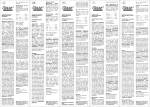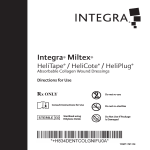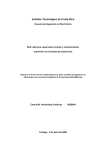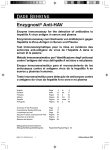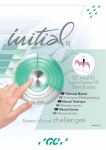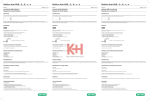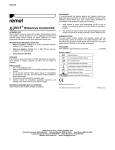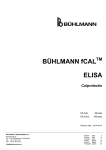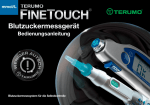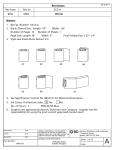Download VDRL Cardiolipin Antigen
Transcript
VDRL Cardiolipin Antigen Intended Use VDRL (Venereal Disease Research Laboratory) Cardiolipin Antigen is a precipitation reagent that aids in the detection and quantification of lipoidal antibodies in serum. The test was developed for testing individual samples, not for pooled samples. The product is for in vitro diagnostic use only. Summary and Explanation The detection and quantification of lipoidal antibodies is of diagnostic importance in connection with the diagnosis of syphilis, primarily for follow-up and assessment of the effectiveness of therapy1-5. The findings obtained must be considered in conjunction with the results of treponemaspecific tests (Enzygnost® Syphilis, IgM-FTA-ABS, FTA-ABS, indirect hemagglutination). Refer to the relevant literature for the evaluation of findings. Principle of the Method Serum or liquor is mixed with cardiolipin antigen on a slide. The presence of anti-lipoidal antibodies causes agglutination (formation of precipitate) with cardiolipin antigen. If no anti-lipoidal antibodies are present, the suspension remains cloudy throughout. Quantitative determination of antibody content For the determination of cardiolipin antibodies, the slide test is performed with 50 µL each of a geometric dilution series of the inactivated serum. Dilution fluid is recommended for the dilution of serum. The corrected mean titer or the number of International Units per mL is based on comparative titration of the Lues Standard Serum according to the recommendations of the German Federal Health Authority. The titer is the reciprocal value of the last dilution level to be determined as "reacting". Limitations of the Procedure 1. Incompletely coagulated sera and microbially contaminated test samples should not be used. Any particulates (e.g. fibrin clots, erythrocytes) contained in the samples should be removed prior to assay. 2. If thawed samples are used, ensure that the material is thoroughly homogenized. 3. The reagent is only suitable for testing individual samples, not for pooled samples. 4. The instructions given for the preparation of the antigen suspension must be followed very closely. Specific Performance Characteristics Reagents VDRL Cardiolipin Antigen is suitable for the detection of anti-lipoidal IgG and IgM antibodies. The performance of each lot of reagent is tested with clinically known positive and negative controls. Materials provided in the VDRL kit: VDRL Cardiolipin Antigen 1 pcs. Dilution liquid 1 pcs. Instructions for use 1 pcs. Bibliography 1. Bekämpfung von Geschlechtskrankheiten, Richtlinien zur Serodiagnose der Syphilis; K.-E. Gillbert; Bundesgesundheitsblatt 18, 1-7 (1975) 2. Richtlinien 1979 Serodiagnose der Syphilis; K.-E. Gillbert; Bundesgesundheitsblatt 22 (1979), 398-400 3. Neue Entwicklung auf dem Gebiet der Syphilisserologie; A. Luger; Wiener klininische Wochenschrift, 92. Jahrgang, 11(1980, 375-379) 4. Moderne Serologie der Syphilis; H. J. Hagedorn, P. Naumann; Dtsch. med. Wschr. 104 (1979), 209-214 Composition VDRL Cardiolipin Antigen, bovine, in alcoholic solution: Cardiolipin 0.3 g/L Lecithin 2.1 g/L Cholesterol 9.0 g/L Dilution fluid Formaldehyde Na2HPO4 x 12 H2O KH2PO4 NaCl 0.58 g/L 93 mg/L 170 mg/L 10.0 g/L 5. Moderne serologische Syphilis-Diagnostik; H.P. Geisen, H.P, Seelig; Lab. med. 3, 23 (1979) Warnings and Precautions 1. For in vitro diagnostic use only. 2. VDRL Cardiolipin is contained in an alcoholic solution and is highly flammable. The container must be kept tightly closed and removed from sources of ignition. 3. It is advisable to wear protective gloves throughout the entire test procedure. 4. For the disposal of solid infectious materials, autoclaving for at least 1 hour at +121 °C is recommended. Disinfectants suitable for inactivating human pathogens may also be used. The concentrations and times specified by the manufacturer must be observed. Preparations of Reagents Preparation of the Antigen Suspension Put 0.4 mL dilution fluid into a glass vial and then slowly add 0.5 mL of antigen while agitating. Do not allow the pipette to come into contact with the dilution fluid. Squeeze out the last few drops and then gently agitate the fluid by swaying it from side to side a few seconds more. Add 4.1 mL dilution fluid, close the vial, and shake vigorously. The suspension must be used within one day. Preparation of serum Inactivate sera for 30 minutes at +56 °C ±2 °C. Samples that have already been inactivated must be inactivated again after more than 4 hours for 10 minutes at +56 °C ±2 °C. Liquors are not inactivated. Storage and Stability All components of the test kit may be used up to the date indicated on the label if stored at a temperature between +15 to +25 °C. For complete stability and storage data for opened reagents or reagents diluted for use, see the following table. Reagent State Storage Stability VDRL Cardiolipin Antigen after opening tightly closed diluted ready for use after opening tightly closed +15 to +25 °C up to expiry date +15 to + 25 °C +15 to +25 °C 1 day up to expiry date VDRL-Cardiolipin-Antigen Dilution liquid Materials required but not provided Lues Standard Serum (Code No. ORDN) as a control for the reaction and for quantitative evaluation of cardiolipin antibodies. Slides with wells. Specimens Suitable specimens for testing are individual serum samples obtained by standard laboratory techniques. The samples should be stored for no longer than 3 days at +2 to +8 °C. If the samples are to be stored for a longer period of time, they must be frozen. Inactivate the sera before testing for 30 minutes at +56 °C ±2 °C. Procedure Slide Test with Serum 1. Dispense and distribute 50 µL inactivated serum onto a slide with wells (14 mm). 2. Add 17 µL antigen suspension with a piston-type pipette. 3. Agitate for 4 minutes on a rotation device (180 ± 50 rpm and 1.9 cm circular movement). The assessment is performed immediately upon finishing the rotation with a microscope at 100 fold magnification: no agglutination non-reacting agglutination not clearly recognizable questionable reaction small but clear agglutination weak reaction strong agglutination reacting ORAA G11 C0840 (140) S Internal Quality Control Lues Standard Serum is used as a control for internal quality control. 1 Enzygnost is a registered trademark of Dade Behring Marburg GmbH in the USA, Germany and other countries. Dade Behring Marburg GmbH Emil-von-Behring-Str. 76 D-35041 Marburg www.dadebehring.com USA Distributor: Dade Behring Inc. Newark, DE 19714 U.S.A. Edition December 2003 VDRL-Cardiolipin-Antigen Anwendungsbereich VDRL (Venereal Disease Research Laboratory)-Cardiolipin-Antigen ist ein Flockungsreagenz und dient zum Nachweis und zur Quantifizierung des Lipoid-Antikörpers in Serum. Der Test wurde entwickelt für die Untersuchung von Einzelproben, nicht von gepoolten Proben. Das Produkt darf nur für in-vitro-diagnostische Zwecke angewendet werden. Diagnostische Bedeutung Der Nachweis und die Quantifizierung von lipoidalen Antikörpern ist im Rahmen der Lues-Diagnostik vor allem für die Verlaufskontrolle und zur Beurteilung des Therapieerfolges von diagnostischer Bedeutung1-5. Dabei müssen die erhobenen Befunde im Zusammenhang mit Ergebnissen treponemenspezifischer Tests (Enzygnost® Syphilis, lgM-FTA-ABS, FTA-ABS, indirekte Hämagglutination) gesehen werden. Zur Befundbeurteilung wird auf die einschlägige Literatur verwiesen. Prinzip der Methode Serum bzw. Liquor wird auf einem Objektträger mit Cardiolipin-Antigen vermischt. Bei Vorhandensein antilipoidaler Antikörper kommt es zur Agglutination (Flockenbildung) mit Cardiolipin-Antigen. Im negativen Fall bleibt die Suspension gleichmäßig trüb. Reagenzien Inhalt der Handelspackung VDRL: VDRL-Cardiolipin-Antigen 1 Stück Verdünnungsflüssigkeit 1 Stück Packungsbeilage 1 Stück Haltbarkeit und Lagerungsbedingungen Ungeöffnet sind alle Bestandteile des Testkits bei einer Lagerungstemperatur von +15 bis +25 °C bis zu dem auf den Etiketten angegebenen Datum verwendbar. Die Haltbarkeits- und Lagerungsbedingungen der geöffneten bzw. gebrauchsverdünnten Reagenzien sind der nachfolgenden Tabelle zu entnehmen. Lagerung +15 bis +25 °C Stabilität bis Verfallsdatum +15 bis +25 °C +15 bis +25 °C 1 Tag bis Verfallsdatum Zusätzlich benötigte Materialien Lues-Standardserum (Bestell-Nr. ORDN) zur Kontrolle der Reaktion und Quantifizierung des Cardiolipin-Antikörpers. Objektträger mit Vertiefungen. Untersuchungsmaterial Zur Untersuchung können Einzelseren verwendet werden, welche nach Standard-Labortechniken entnommen wurden. Die Proben sollten maximal 3 Tage bei +2 bis +8 °C gelagert werden. Zur längeren Lagerung sind die Proben einzufrieren. Die Seren werden vor der Bestimmung 30 Min. bei +56 °C ±2 °C inaktiviert. Testdurchführung Objektträgertest mit Serum 1. 50 µl inaktiviertes Serum auf einen Objektträger mit Vertiefungen (14 mm) geben und verteilen. 2. 17 µl Antigensuspension mittels einer Kolbenhubpipette zugeben. 3. 4 Min. lang auf einem Rotationsapparat (180 ± 50 UpM und einer 1,9 cm Kreisbewegung) bewegen. Die Beurteilung erfolgt sofort nach Beendigung der Rotation mit Mikroskop bei 100-facher Vergrößerung: keine Verklumpung nicht reagierend nicht sicher erkennbare Verklumpung fraglich reagierend kleine, aber deutliche Verklumpung schwach reagierend stärkere Verklumpung reagierend 2 Das VDRL-Cardiolipin-Antigen ist zum Nachweis von antilipoidalen IgG- und IgM-Antikörpern gegeignet. Die Leistungsfähigkeit des Reagenzes wird bei jeder Charge mit klinisch bekannten positiven und negativen Kontrollen überprüft. Ausgabe Dezember 2003 Serumvorbereitung Seren 30 Min. bei +56 °C ±2 °C inaktivieren. Bereits inaktivierte Proben werden nach mehr als 4 Stunden erneut 10 Min. bei +56 °C ±2 °C inaktiviert. ORAA G11 C0840 (140) S Leistungsmerkmale des Tests Dade Behring Marburg GmbH Emil-von-Behring-Str. 76 D-35041 Marburg www.dadebehring.com Vorbereitung der Reagenzien Herstellung der Antigensuspension 0,4 ml Verdünnungsflüssigkeit in eine Glasflasche geben und 0,5 ml Antigen langsam unter Schütteln zusetzen. Die Pipette darf nicht mit der Verdünnungsflüssigkeit in Berührung kommen. Letzten Tropfen ausblasen und die Flüssigkeit noch einige Sekunden schwenken. 4,1 ml Verdünnungsflüssigkeit zusetzen, Flasche verschließen, kräftig vertikal schütteln. Die Suspension darf nur innerhalb eines Tages verwendet werden. VDRL-Cardiolipin-Antigen Verdünnungsflüssigkeit 1. Ungenügend geronnene Seren und mikrobiell kontaminierte Untersuchungsproben sollten nicht eingesetzt werden. Eventuell vorhandene partikuläre Komponenten (z.B. Fibrin-Gerinnsel, Erythrozyten) sollten vor der Testdurchführung entfernt werden. 2. Bei aufgetauten Proben ist auf eine gute Homogenisierung des Materials zu achten. 3. Das Reagenz ist nur für die Untersuchung von Einzelproben nicht von gepoolten Proben geeignet. 4. Die gegebenen Hinweise sind bei der Herstellung der Antigensuspension sehr genau einzuhalten. Enzygnost ist eine eingetragene Marke der Dade Behring Marburg GmbH in den USA, Deutschland und anderen Ländern. 0,58 g/l 93 mg/l 170 mg/l 10,0 g/l Zustand nach Öffnen, dicht verschlossen gebrauchsverdünnt nach Öffnen, dicht verschlossen Einschränkungen der Testdurchführung Siehe englische Packungsbeilage. Warnungen und Vorsichtsmaßnahmen 1. Nur zur in-vitro-diagnostischen Anwendung. 2. Das VDRL-Cardiolipin liegt in alkoholischer Lösung vor und ist leicht entzündlich. Der Behälter ist dicht verschlossen und von Zündquellen fern zu halten. 3. Das Tragen von Untersuchungshandschuhen während der gesamten Testdurchführung wird angeraten. 4. Für die Entsorgung infektiöser Materialien empfiehlt sich eine Autoklavierung von mindestens 1 Stunde bei +121 °C. Es können auch Desinfektionsmittel eingesetzt werden, die geeignet sind, human-pathogene Erreger zu inaktivieren. Die vom Hersteller angegebenen Konzentrationen und Einwirkzeiten müssen beachtet werden. Reagenz VDRL-Cardiolipin-Antigen Quantitative Bestimmung des Antikörpergehaltes Zur Bestimmung des Cardiolipin-Aritikörpers wird der Objektträgertest mit je 50 µl einer geometrischen Verdünnungsreihe des inaktivierten Serums durchgeführt. Für die Verdünnung von Serum wird die Verwendung von Verdünnungsflüssigkeit, empfohlen. Der korrigierte mittlere Titer bzw. die Anzahl der internationalen Einheiten pro ml ergeben sich entsprechend den Empfehlungen des Bundesgesundheitsamtes durch vergleichende Titration des Lues-Standardserum. Als Titer wird der Reziprokwert der letzten Verdünnungsstufe bezeichnet, der als "reagierend" festgestellt wird. Literatur Zusammensetzung VDRL-Cardiolipin-Antigen, vom Rind, enthält in alkoholischer Lösung: Cardiolipin 0,3 g/l Lecithin 2,1 g/l Cholesterin 9,0 g/l Verdünnungsflüssigkeit Formaldehyd Na2HPO4 x 12 H2O KH2PO4 NaCl Interne Qualitätskontrolle Zur internen Qualitätskontrolle wird das Lues-Standardserum als Kontrolle eingesetzt. Antigène cardiolipidique VDRL Contrôle de qualité interne Pour le contrôle de qualité interne, utiliser le Sérum standard Syphilis comme contrôle. L’Antigène cardiolipidique VDRL (Venereal Disease Research Laboratory) est un réactif d’agglutination qui permet la mise en évidence et la quantification d'anticorps anti-lipoïdal dans le sérum. Le test a été mis au point pour l’analyse d’échantillons individuels, et non d’échantillons poolés. Il ne peut être utilisé qu’à des fins de diagnostic in vitro. Détermination quantitative du taux d’anticorps Pour doser l’anticorps anti-cardiolipine, effectuer le test sur lame porte-objet avec 50 µl d'une série géométriques de dilutions du sérum inactivé. Pour établir les dilutions du sérum, il est recommandé d'utiliser le liquide de dilution. Déterminer le titre moyen corrigé ou le nombre d’unités internationales par ml selon les recommandations du Ministère de la Santé allemand, par titrage comparé avec le Sérum standard Syphilis. Le titre correspond à la valeur réciproque de la plus haute dilution considérée comme "réactive". Intérêt diagnostique Limites du test Domaine d’utilisation La mise en évidence et la quantification des anticorps anti-lipoïdaux dans la cadre de l’exploration de la syphilis présentent surtout un intérêt particulier pour le contrôle du suivi et l’évaluation du succès d’un traitement1-5. Cependant, les résultats doivent toujours être lus en liaison avec ceux obtenus dans les tests tréponémiques spécifiques (Enzygnost® Syphilis, IgM-FTA-ABS, FTAABS, hémagglutination indirecte). Pour l’interprétation des résultats, se reporter à la littérature correspondante. Principe de la méthode Le sérum ou le LCR est mélangé à de l’antigène cardiolipidique sur une lame porte-objet. En présence d’anticorps anti-lipoïdaux, il se forme une agglutination entre ces anticorps et l’antigène cardiolipidique. Sinon, la suspension garde une turbidité régulière. Réactifs Contenu du coffret VDRL : Antigène cardiolipidique VDRL Liquide de dilution Fiche technique Enzygnost est une marque déposée de Dade Behring Marburg GmbH aux USA, en Allemagne et dans d’autres pays. Dade Behring Marburg GmbH Emil-von-Behring-Str. 76 D-35041 Marburg www.dadebehring.com Edition Décembre 2003 Mises en garde et précautions d’emploi 1. Réservé à un usage de diagnostic in vitro. 2. L’Antigène cardiolipidique VDRL en solution alcoolisée est facilement inflammable. Bien fermer le flacon et le tenir éloigné de toute source inflammable. 3. Il est recommandé de porter des gants de protection pendant toute la réalisation du test. 4. Pour décontaminer le matériel de laboratoire ainsi que les solutions infectés, les autoclaver pendant au moins 60 min à +121 °C. Il est également possible d’utiliser un désinfectant approprié pour inactiver les virus pathogènes pour l’Homme. Respecter alors les concentrations et temps d’incubation indiqués par le fabricant. Préparation du réactif Préparation de la suspension d’antigène Verser 0,4 ml de Liquide de dilution dans un récipient en verre, puis distribuer lentement, tout en agitant le récipient, 0,5 ml d’Antigène. Veiller à ce que la pipette n’entre pas en contact avec le Liquide de dilution. Faire tomber les dernières gouttes d’Antigène, puis remuer la solution en renversant légèrement le récipient à plusieurs reprises pendant quelques secondes. Ajouter 4,1 ml de Liquide de dilution, refermer le flacon, et agiter énergiquement en secouant le flacon á la verticale. La suspension ainsi préparée doit être utilisée dans la journée. Préparation des sérums Inactiver les sérums pendant 30 min à +56 °C ±2 °C. Si les échantillons ont été inactivés depuis plus de 4 heures, les inactiver de nouveau 10 min à +56 °C ±2 °C. Stabilités et conditions de conservation Tous les réactifs conservés à +15/+25 °C dans leur flacon d’origine non ouvert peuvent être utilisés jusqu’à la date indiquée sur l’étiquette Stabilités et conditions de conservation des échantillons et réactifs après ouverture des flacons ou préparation des solutions à la dilution d’emploi : Conservation +15/+25 °C Stabilité jusqu’à date de péremption +15/+25 °C 1 jour +15/+25 °C jusqu’à date de péremption Autre réactif et matériel nécessaire Sérum standard Syphilis (code ORDN) pour le contrôle de la réaction et la quantification d'anticorps anti-cardiolipine. Lame porte-objet à concavités. Echantillons á tester Utiliser des sérums individuels prélevés selon les techniques standard de laboratoire. Les conserver 3 jours maximum à +2/+8 °C. Pour une conservation plus longue, les congeler. Inactiver les sérums 30 min à +56 °C ±2 °C avant leur utilisation dans le test. Réalisation du test Test sur lame porte-objet avec sérum 1. Distribuer 50 µl de sérum inactivé dans les concavités (14 mm) d’une lame porte-objet, et répartir la solution dans chaque concavité. 2. Ajouter 17 µl de suspension d’antigène à l’aide d’une pipette à embout interchangeable. 3. Agiter pendant 4 min sur un appareil à rotation (180 ± 50 rév/min et 1,9 cm de diamètre). Procéder à l’interprétation des résultats dès la fin de la rotation par une lecture au microscope avec un grossissement x 100 : Pas d’agglutination non réactif Agglutination douteuse réaction douteuse Agglutination faible mais nette réaction faible Forte agglutination réactif 3 L’Antigène cardiolipidique VDRL est approprié pour la mise en évidence des anticorps anti-lipoïdaux de type IgG et IgM. Son efficacité est contrôlée à chaque lot à l’aide de contrôles positifs et négatifs connus. Voir mode d’emploi anglais. Composition Antigène cardiolipidique VDRL, de bœuf, en solution alcoolisée ; contient : cardiolipine 0,3 g/l lécithine 2,1 g/l cholestérol 9,0 g/l Liquide de dilution formaldéhyde 0,58 g/l Na2HPO4 x 12 H20 93 mg/l KH2PO4 170 mg/l NaCl 10,0 g/l ORAA G11 C0840 (140) S Caractéristiques du test Littérature 1 flacon 1 flacon 1 Réactif Etat Antigène cardioaprès ouverture, lipidique VDRL dans flacon bien fermé Antigène cardioDilué a la dilution d'emploi lipidique VDRL Liquide de dilution après ouverture, dans flacon bien fermé 1. Ne pas utiliser de sérums insuffisamment coagulés ni d’échantillons contaminés. Eliminer avant le début du test les éventuels éléments particulaires (par ex. caillot de fibrine, érythrocytes). 2. En cas d’utilisation d’échantillons congelés, veiller à leur bonne homogénéisation. 3. Le test ne doit être effectué que sur des échantillons individuels, et non sur des échantillons poolés. 4. Respecter scrupuleusement les étapes indiquées pour la préparation de la suspension antigénique. Antigene cardiolipina VDRL Settore d’impiego L’antigene cardiolipina VDRL (Venereal Disease Research Laboratory) è un reagente precipitante che serve all’identificazione ed alla quantificazione degli anticorpi lipoidei nel siero. Il test è stato sviluppato per analizzare singoli campioni e non pool di campioni. Il prodotto è soltanto per uso diagnostico in vitro. Significato diagnostico La rilevazione e la quantificatione degli anticorpi lipoidei è di importanza diagnostica congiuntamente alla diagnosi di sifilide, principalmente per il monitoraggio e la valutazione dell'efficcia della terapia1-5. I dati ottenuti devono essere valutati tenendo conto dei risultati dei test specifici per i treponemi (Enzygnost® Sifilide, IgM-FTA-ABS, FTA-ABS, emoagglutinazione indiretta). Per la valutazione dei risultati, fare riferimento alla letteratura pertinente. Principio del metodo Il siero o liquor viene mescolato con antigene cardiolipina su un portaoggetti. In presenza di anticorpi anti-lipoidei, si verifica un’agglutinazione (flocculazione) con l’antigene cardiolipina. In assenza di anticorpi anti-lipoidei, la sospensione rimane uniformemente torbida. Reagenti Contenuto della confezione VDRL: Antigene cardiolipina VDRL 1 pz Diluente 1 pz Foglietto illustrativo 1 pz 0,58 g/L 93 mg/L 170 mg/L 10 g/L Avvertenze e precauzioni 1. Solo per uso diagnostico in vitro 2. La cardiolipina VDRL è contenuta in una soluzione alcolica altamente infiammabile. Tenere il contenitore ben chiuso lontano da sostanze combustibili. 3. Si raccomanda di utilizzare guanti protettivi durante l’intera esecuzione del test. 4. Per lo smaltimento del materiale solido infettivo, si raccomanda il trattamento in autoclave a +121 °C per almeno 1 ora. Si possono utilizzare anche disinfettanti idonei all’inattivazione degli agenti patogeni umani. Rispettare la concentrazione e il tempo d’azione indicati dal produttore. Preparazione dei reagenti Preparazione della sospensione antigene Distribuire 0,4 mL di diluente, in un flacone di vetro e aggiungere lentamente 0,5 mL di antigene, agitando continuamente il flacone. Fare attenzione che la pipetta non venga in contatto con il diluente. Lasciar cadere soffiando l’ultima goccia ed agitare il liquido ancora per alcuni secondi. Aggiungere 4,1 mL di diluente, chiudere il flacone, ed agitare energicamente. La sospensione dev’essere utilizzata in giornata. Preparazione del siero Inattivare i sieri per 30 minuti a +56 °C ±2 °C. I campioni già inattivati da oltre 4 ore, devono essere inattivati di nuovo a +56 °C ± 2 °C per 10 minuti. Non inattivare i campioni di liquor. Conservazione e stabilità Tutte le componenti sigillate del kit, conservate a +15/+25 °C, possono essere utilizzate entro la data indicata sull’etichetta. I dati sulla conservazione e la stabilità dei reagenti aperti e dei reagenti diluiti per l’uso, sono riportati nella tabella seguente. Reagente Stato Antigene cardiolipina VDRL dopo apertura chiuso ermeticamente Antigene cardiolipina VDRL diluto pronto per l'uso Diluente dopo apertura chiuso ermeticamente Conservazione +15/+25 °C Stabilità data di scadenza +15/+25 °C +15/+25 °C 1 giorno data di scadenza Materiale necessario ma non fornito Siero luetico standard (codice ORDN) per il controllo della reazione e per la valutazione quantitativa degli anticorpi cardiolipina. Portaoggetti con pozzetti. Campioni in esame Utilizzare come campioni da analizzare, sieri singoli prelevati secondo le tecniche di laboratorio standard. Non conservare i campioni più di 3 giorni a +2/+8 °C. Per una conservazione più lunga, i campioni devono essere congelati. Prima del test, inattivare i sieri per 30 minuti a +56 °C ±2 °C. Esecuzione del test Test su portaoggetti con siero 1. Dispensare sul portaoggetti con pozzetti 50 µL di siero inattivato e distribuirlo. 2. Aggiungere 17 µL di sospensione di antigene usando una pipetta a stantuffo. 3. Agitare per 4 minuti su agitatore fotante (180 ± 50 rpm con movimento circulare di 1,9 cm). Leggere subito, a rotazione ultimata, con il microscopio ad un ingrandimento di 100 x: assenza di aggregati non reattivo aggregati non chiaramente riconoscibili reattivo dubbio aggregati piccoli ma chiaramente riconoscibili debolmente reattivo aggregati grandi reattivo Controllo di qualità interno Per il controlle di qualità interno viene utilizzato Lues Standard Serum. Determinazione quantitativa del titolo anticorpale Per la determinazione degli anticorpi anti-cardiolipina, il test su vetrino viene eseguito con 50 µL di ciascuna delle diluizioni seriali geomeriche del siero inattivato. Si raccomanda l'apposito diluente per diluire il siero. Il titolo medio corretto o il numero di unità internazionali per ml si ottengono, secondo le raccomandazioni delle Autorità sanitarie della Repubblica Federale Tedesca, dal confronto con la titolazione del siero luetico standard. Il titolo è dato dal valore reciproco dell’ultima diluizione valutata come "reattiva". ORAA G11 C0840 (140) S 4 1. Non utilizzare sieri non completamente coagulati e campioni da analizzare contaminati microbiologicamente. Eventuali particelle (ad es. coaguli di fibrina, eritrociti) presenti nel campione devono essere eliminate prima del test 2. Se si utilizzano campioni scongelati, assicurarsi che siano completamente omogeneizzati 3. Il reagente è adatto solo per analizzare singoli campioni, non pool di campioni. 4. Rispettare esattamente le istruzioni per la preparazione della sospensione degli antigeni. Caratteristiche del test L’antigene cardiolipina VDRL è indicato adatto per l’identificazione degli anticorpi antilipoidei IgG e IgM. Il rendimento di ciascun lotto di reagente viene analizzato con controlli positivi e negativi clinicamente noti. Bibliografia Vedi testo Inglese. Enzygnost è un marchio registrato della Dade Behring Marburg GmbH negli USA, in Germania e negli altri Paesi. Dade Behring Marburg GmbH Emil-von-Behring-Str. 76 D-35041 Marburg www.dadebehring.com Edizione Dicembre 2003 Composizione Antigene cardiolipina, bovina, in soluzione alcolica: Cardiolipina 0,3 g/L Lecitina 2,1 g/L Colesterolo 9,0 g/L Diluente: Formaldeide Na2HPO4 x 12 H2O KH2PO4 NaCl Limitazioni della esecuzione del test Antígeno VDRL-Cardiolipina Campos de aplicación El antígeno VDRL (Venereal Disease Research Laboratory)- cardiolipina es un reactivo de floculación y sirve para el reconocimiento y la cuantificación del valor del anticuerpo lipiode en suero . El test fue desarrollado para la investigación de muestras individuales no de muestras en pool. El producto debe ser usado únicamente en diagnósticos in vitro. Significado diagnóstico El reconocimiento y la cuantificación del valor de los anticuerpos lipoidales es, en el marco del diagnóstico de Lúes, de significado diagnóstico sobre todo en el control del desarrollo y la valoración del éxito de la terapeútica1-5. En este caso los resultados se deben ver en relación con los resultados de test específicos de treponemas (Enzygnost® Sífilis, IgM-FTA-ABS, Hemaglutinación indirecta). Para la interpretación del resultado se remite a la literatura correspondiente. Limitaciones del Procedimiento 1. Los sueros no suficientemente coagulados y las muestras a investigar contaminadas microbiológicamente no se deben utilizar en el test. Las partículas eventualmente existentes (por ej., coágulos de fibrina, eritrocitos) deben ser retiradas antes de empezar con el test. 2. Con las muestras descongeladas, se debe observar que haya una buena homogenización del material. 3. El reactivo es apropiado únicamente para muestras individuales, no para muestras en pool. 4. Las advertencias dadas se deben observar cuidadosamente en la preparación de la suspensión del antígeno. Características del test Principio del método El suero o el liquido cefalorraquídeo se mezclan con el antígeno cardiolipina sobre un portaobjetos. Si existen anticuerpos antilipiodales se presenta una aglutinación (formación de copos). En el caso negativo la suspensión permanece uniformemente turbia. Reactivos El Antígeno VDRL-Cardiolipina es apropiado para el reconocimiento de los anticuerpos IgG e IgM antilipoidales. Las características del reactivo van a ser comprobadas para cada lote con controles clínicos positivos y negativos conocidos. Bibliografía Contenido del envase comercial VDRL: Antígeno VDRL-Cardiolipina 1 unidad Líquido diluyente 1 unidad Boletín informativo 1 unidad Ver texto en inglés. Enzygnost es una marca de fabrica registrada de Dade Behring Marburg GmbH en USA, Alemania y otros países. Composición Antígeno VDRL-Cardiolipina, bovino, contiene en solución alcohólica: Cardiolipina 0,3 g/l Lecitina 2,1 g/l Colesterina 9,0 g/l Líquido diluyente Formaldehído Na2HPO4 x 12 H2O KH2PO4 NaCl Dade Behring Marburg GmbH Emil-von-Behring-Str. 76 D-35041 Marburg www.dadebehring.com Edición Diciembre 2003 0,58 g/l 93 mg/l 170 mg/l 10,0 g/l Advertencia y medidas de seguridad: 1. Sólo para el uso en diagnósticos in vitro. 2. El Antígeno VDRL-Cardiolipina viene en una solución alcohólica y es fácilmente inflamable. Mantener el recipiente perfectamente cerrado y lejos de focos de ignición. 3. Se aconseja utilizar guantes de seguridad durante todo el desarrollo del test. 4. Para la eliminación de materiales infecciosos se recomienda su colocación en el autoclave por lo menos durante 1 hora, a +121°C. También se pueden emplear medios de desinfección, que sean apropiados para inactivar agentes patógenos humanos. Los datos sobre concentración y tiempo de acción dados por el fabricante deben ser observados. Preparación del reactivo Elaboración de la suspensión del antígeno Agregar 0,4 ml de líquido diluyente en un frasco de vidrio y añadir lentamente, bajo agitación, 0,5 ml del antígeno. La pipeta no debe entrar en contacto con el líquido diluyente. Soplar la última gota y agitar el líquido unos segundos más. Añadir 4,1 ml de líquido diluyente, cerrar la botella y agitar fuertemente de forma. La suspensión debe usarse únicamente en el plazo de un día. Preparación del suero Inactivar los sueros durante 30 min. a +56 °C ±2 °C. Las muestras se vuelven a inactivar nuevamente a +56 °C ±2 °C después de 4 horas. Las muestras de líquido cefalorraquídeo no se inactivan. Estabilidad y almacenaje Todos los componentes del testkit, sin abrir y almacenados a una temperatura entre +15 y +25 °C se pueden usar hasta la fecha de vencimiento dada en la etiqueta. La estabilidad y las condiciones de almacenamiento de los reactivos abiertos o de las diluciones de uso se pueden tomar de la siguiente Tabla. Reactivo Antígeno VDRLCardiolipina Antígeno VDRLCardiolipina Líquido diluyente Determinación cuantitativa del contenido de anticuerpos Para la determinación del anticuerpo cardiolipina efectuar el ensayo el portaobjetos con 50 µl, por c/u, de una serie de diluciones geométrica del suero inactivo. Para diluir el suero se recomienda usar el líquido diluyente. El valor medio del título corregido o el número de unidades internacionales por ml se obtienen de acuerdo a las recomendaciones del Ministerio de Salud Alemán por comparación con una titulación similar con el suero estándar Lúes. Como título se define el valor reciproco de la última dilución que se pueda dar como "reactiva". Estado sin abrir bien cerrado se utiliza diluido Almacenamiento entre +15 y +25 °C sin abrir bien cerrado entre +2 y +8 °C entre +15 y +25 °C Estabilidad hasta la fecha de vencimiento 1 día hasta la fecha de vencimiento Materiales adicionales necesarios Suero estándar Lúes (N° de pedido ORDN) para el control de la reacción y la cuantificación del anticuerpo cardiolipina. Portaobjetos con cavidad. Material a investigar Para la investigación se pueden usar sueros individuales que hayan sido tomados de acuerdo con las técnicas estándar de laboratorio. Las muestras se pueden almacenar máximo 3 días entre +2 y +8 °C. Para un mayor tiempo de almacenamiento se deben congelar. Los sueros se inactivan a +56 °C ±2 °C 30 min. antes de la determinación. Procedimiento Ensayo con suero en el portaobjetos 1. Agregar 50 µl del suero inactivado al portaobjetos con cavidad (14 mm) y repartirlo 2. Añadir 17 µl de la suspensión de antígeno con una pipeta de émbolo. 3. Colocar durante 4 min. en un aparato de rotación (180 + 50 r.p.m. y un circulo de movimiento de 1,9 cm). La interpretación se efectúa directamente después de que el rotor se detiene utilizando un microscopio con un aumento de 100-veses: Ninguna aglomeración no reactivo Aglomeración no muy reconocible reactividad incierta Aglomeración pequeña, pero clara reactividad débil Aglomeración fuerte reactivo Control de calidad interno Para el control de calidad interno usar el suero estándar de Lúes como control. ORAA G11 C0840 (140) S 5 Results of Cardiolipin Microflocculation Test with Serum (magnified 100 x) Reaktionsausfall des Cardiolipin-Mikroflockungstestes im Serum (100fache Vergrößerung) Résultat de la réaction de micro-floculation cardiolipidique dans le sérum (grossissement par 100) Risultati del Test di Microflocculazione alla Cardiolipina su siero (ingrandimento 100 x) Resultados de la reacción del test de microfloculación de cardiolipina en el suero (aumento de 100 veces) – = non reactive/nicht reagierend/ négatif/non rattivo/negativo ± = borderline reactive/fraglich ±= reagierend/positif douteux rattivo dubbio/reacción dudosa + = weakly reactive/schwach += reagierend/positif faible/ debolmente reattivo/débilmente positivo ++ = reactive/reagierend/ positif/reattivo/positivo +++= reactive/reagierend/ +++= positif/reattivo/positivo ++++= reactive/reagierend/ ++++= positif/reattivo/positivo Symbols Key / Symbolschlüssel / Explication des Symboles / Interpretazione simboli / Clave de los Símbolos / Chave dos Símbolos Manufactured by / Hergestellt von / Fabriqué par / Prodotto da / Fabricado por IVD LOT EXP CCYY-MM-DD In Vitro Diagnostic Medical Device / In Vitro Diagnosticum / Dispositif Médical Diagnostic In Vitro / Dispositivo Medico per Diagnostica In Vitro / Producto sanitario para Diagnóstico In Vitro Lot Number / Chargenbezeichnung / Numéro de Lot / Numero di Lotto / Número de Lote Expiration Date / Verfalldatum / Date de Péremtion / data di scadenza / Fecha de vencimiento / termo da validade Storage Temperature / Lagertemperatur / Température de Conservation / Temperatura di conservazione / Temperatura de almacenamiento / Temperatura de armazenagem CE Mark / CE-Zeichen / Marquage CE / Marchio CE / CE Marca / Marca CE REF Catalogue Number / Katalog Nummer / Référence / Codice Catalogo / Número de Catálogo Consult Instructions for Use / Gebrauchsanweisung beachten / Consulter la Notice d'Utilisation / Istruzioni per l'uso / Consultar Instucciones para el Uso / Consulte as Instruções de Utilização ORAA G11 C0840 (140) S 6






